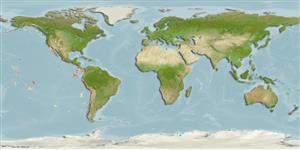Common names from other countries
ຊັ້ນຂອງກຸ່ມປາທີ່ມີຄີຫູໃຫຍ່ຄ້າຍປີກໃນທະເລ (ratfish) (chimaeras) >
Chimaeriformes (Chimaeras) >
Chimaeridae (Shortnose chimaeras or ratfishes)
Etymology: Hydrolagus: hydro-, combining form of hydor (Gr.), water; lagos (Gr.), hare, i.e., “water rabbit,” probably referring to three pairs of tooth plates, which tend to protrude from the mouth like a rabbit’s incisors. (See ETYFish); macrophthalmus: macro-, from makros (Gr.), long; ophthalmos (Gr.), eye, referring to its large oval eyes. (See ETYFish).
Environment: milieu / climate zone / depth range / distribution range
ນິເວດວິທະຍາ
ສັດທະເລ ກ່ຽວກັບ(ຢູ່)ຊັ້ນນ້ຳໃນທະເລທີ່ເໜີອພື້ນດິນ; ລະດັບຄວາມເລິກ 590 - 1160 m (Ref. 97389). Subtropical
Eastern Pacific: from the central coast of Mexico, Costa Rica, Peru and Chile.
ຂະໜາດ / ນ້ຳໜັກ / Age
Maturity: Lm ? range ? - ? cm
Max length : 63.9 cm TL ຕົວຜູ້/ບໍ່ມີເພດ; (Ref. 97389); 58.1 cm TL (female)
This species is distinguished by the following set of characters: slender body; short and bluntly rounded snout; relatively short head (HDL 24.2-24.5% BDL); relatively large eyes (EYL 30.9-34.2% HDL); oral and preopercular lateral line canals sharing a short common branch from the infraorbital canal; relatively large pectoral fins (P1A 36.5-40.8% BDL), extending posterior to the insertion of pelvic fins; trunk's lateral line canal without sinusoidal undulations; the anterior and posterior regions of second dorsal fin considerably taller than middle region; no anal fin; tail region elongate and slender (PCA 58.3-59.9% BDL); caudal-fin axis horizontal with the fin nearly symmetrical, epaxial and hypaxial lobes equal sized; coloration uniform brown across entire body, no white markings and bluish fins (Ref. 97389).
Oviparous (Ref. 205). Eggs are encased in horny shells (Ref. 205).
Life cycle and mating behavior
Maturities | ການສືບພັນ | Spawnings | Egg(s) | Fecundities | ຕົວອ່ອນ
Angulo, A., M.I. López, W.A. Bussing and A. Murase, 2014. Records of chimaeroid fishes (Holocephali: Chimaeriformes) from the Pacific coast of Costa Rica, with the description of a new species of Chimera (Chimaeridae) from the eastern Pacific Ocean. Zootaxa 3861(6):554-574. (Ref. 97389)
IUCN Red List Status (Ref. 130435)
CITES (Ref. 128078)
Not Evaluated
Threat to humans
Harmless
Human uses
ເຄື່ອງມື
Special reports
Download XML
ແຫຼ່ງອີນເຕີເນັດ
Estimates based on models
Phylogenetic diversity index (Ref.
82804): PD
50 = 0.5000 [Uniqueness, from 0.5 = low to 2.0 = high].
Bayesian length-weight: a=0.00282 (0.00118 - 0.00673), b=3.10 (2.89 - 3.31), in cm Total Length, based on LWR estimates for this (Sub)family-body shape (Ref.
93245).
ຊັ້ນເຂດຮ້ອນ (Ref.
69278): 3.8 ±0.6 se; based on size and trophs of closest relatives
ຄວາມຢືດຢຸ່ນ (Ref.
120179): ຕຳ່, ປະຊາກອນຕຳ່ສຸດທີ່ໃຊ້ເວລາສອງເທົ່າ 4.5 - 14 ປີ (Assuming Fec <100).
Fishing Vulnerability (Ref.
59153): Moderate to high vulnerability (46 of 100).
